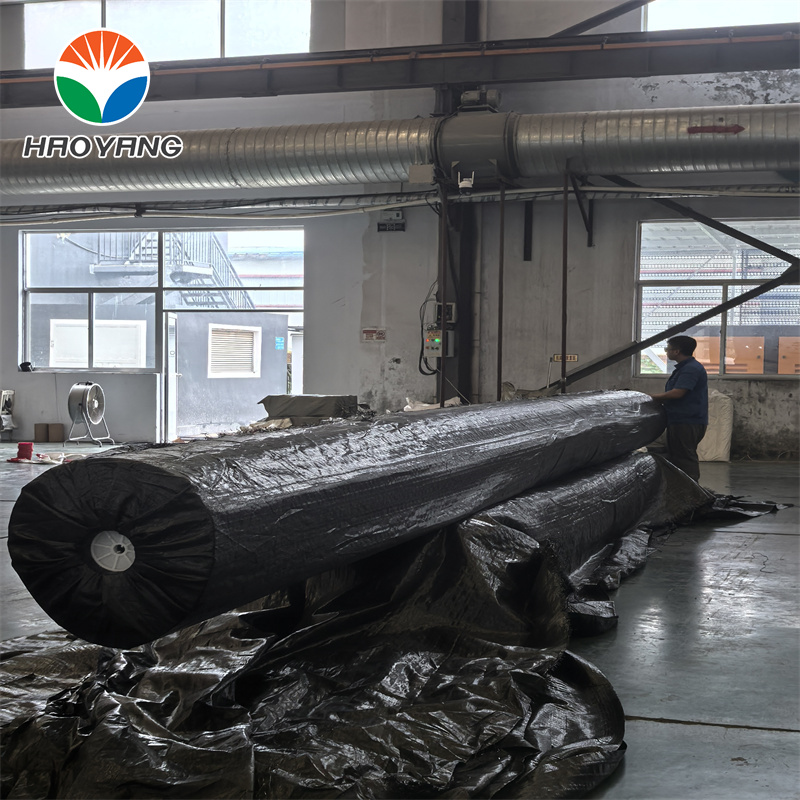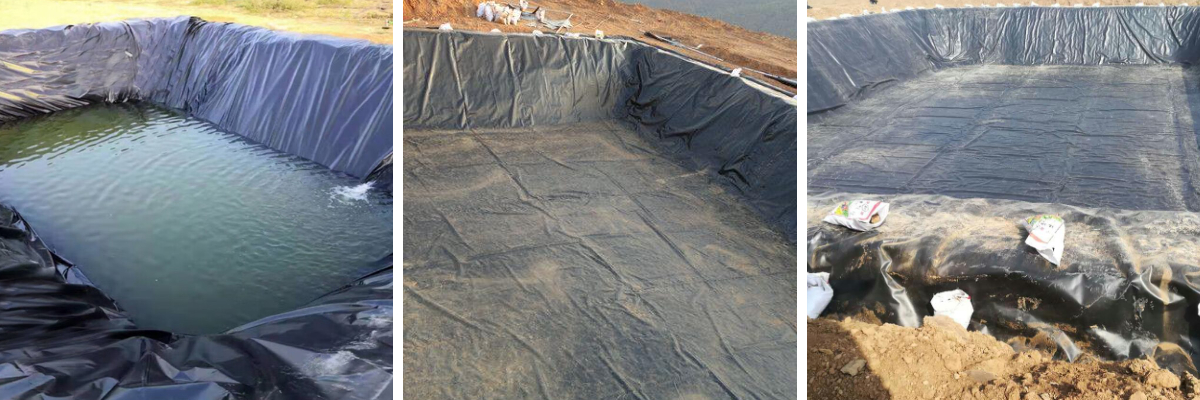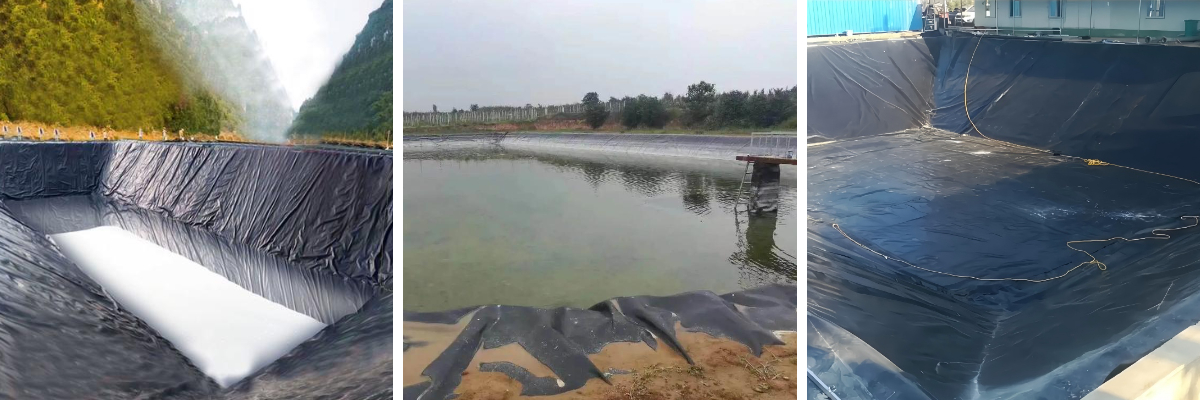Smooth HDPE Geomembrane Pond Liner
1. Excellent waterproofing and chemical resistance for long-term pond protection.
2. High tensile strength and strong UV resistance for stable outdoor performance.
3. Easy installation with customizable thickness and sizes.
4. Ideal for aquaculture, irrigation ponds, reservoirs, and industrial water containment.
I. What Is an HDPE Geomembrane Pond Liner?
An HDPE geomembrane pond liner is a high-density polyethylene membrane used to prevent water seepage, protect soil, and ensure long-term pond stability. It is widely applied in aquaculture ponds, irrigation reservoirs, industrial containment basins, and environmental protection projects. Known for its strength, impermeability, and UV resistance, an HDPE geomembrane pond liner has become the preferred waterproofing solution for modern pond construction.
1. Why HDPE Is the Industry Standard
HDPE is valued for its combination of mechanical strength, chemical resistance, and long service life. Its molecular structure enables high tensile strength, excellent puncture resistance, and minimal environmental degradation. These characteristics make HDPE geomembrane pond liners reliable for both small-scale and large-scale water containment systems.
2. Core SEO Keywords Included
To support Google search visibility, the content incorporates key phrases such as “HDPE geomembrane pond liner,” “pond waterproofing,” “geomembrane liner,” “HDPE pond liner,” and “water containment membrane.”
II. Key Performance Advantages of HDPE Geomembrane Pond Liners
1. Superior Mechanical Strength
HDPE geomembrane pond liners are engineered to withstand high tensile stress and heavy operational loads. Their mechanical performance enables reliable long-term stability, even in demanding environments.
(1) Mechanical Performance Table (Typical ASTM D6693 Data)
| Property | Typical Range | Test Standard | Description |
Tensile Strength at Yield | 14–30 MPa | ASTM D6693 | Ensures resistance to stretching and deformation |
Tensile Strength at Break | 20–40 MPa | ASTM D6693 | Indicates maximum load-bearing capability |
Elongation at Break | 500–900% | ASTM D6693 | High flexibility prevents cracking |
Tear Resistance | 250–430 N | ASTM D1004 | Protects against tearing during installation |
These performance ranges show why HDPE geomembrane pond liners are chosen for ponds requiring structural stability.
2. Outstanding Waterproofing and Low Permeability
One of the defining features of an HDPE geomembrane pond liner is its extremely low permeability.
(1) Water Permeability Comparison
| Material | Typical Permeability Coefficient | Waterproofing Level |
HDPE Geomembrane | ≤ 1 × 10⁻¹³ cm/s | Excellent |
1 × 10⁻⁷ to 1 × 10⁻⁹ cm/s | Moderate | |
Compacted Soil | 1 × 10⁻⁵ to 1 × 10⁻⁶ cm/s | Fair |
HDPE geomembrane achieves near-zero seepage, making it ideal for aquaculture, agricultural ponds, and water conservation systems.
3. Chemical Resistance for Industrial and Agricultural Use
HDPE geomembrane pond liners are widely used in mining, wastewater containment, and agriculture due to their excellent chemical resistance.
(1) Chemical Compatibility Overview
| Chemical Type | Compatibility with HDPE | Notes |
Acids | High | Resistant to common acidic environments |
Alkalis | High | Maintains stability in alkaline ponds |
Salts | High | Ideal for seawater and brackish water aquaculture |
Hydrocarbons | Moderate to High | Depends on specific compound and concentration |
This makes HDPE pond liners suitable for long-term exposure to varied chemical conditions.
4. UV and Aging Resistance for Outdoor Installations
HDPE geomembrane pond liners contain carbon black—usually 2–3%—to provide UV stabilization. This prevents solar degradation and ensures durability in exposed outdoor settings.
(1) UV Resistance Data (Typical Values)
| Property | Typical Range | Description |
Carbon Black Content | 2–3% | Enhances long-term UV stability |
Carbon Black Dispersion | ASTM D5596 Approved | Ensures even protection |
Weathering Resistance | > 20 years (exposed) | Based on global outdoor durability data |
These characteristics ensure reliable performance in ponds exposed to intense sunlight.
III. Applications of HDPE Geomembrane Pond Liners
1. Aquaculture and Fish Farming
HDPE geomembrane pond liners provide a clean, stable, and non-toxic environment for aquaculture systems. Their smooth surface reduces bacterial growth, improves water quality control, and prevents soil contamination.
(1) Benefits for Aquaculture
Prevents seepage and maintains stable water levels
Reduces disease risk from soil pathogens
Improves cleaning efficiency and pond hygiene
Supports higher stocking density due to improved water retention
2. Agricultural Irrigation Ponds
In farming, water conservation is essential. HDPE geomembrane pond liners reduce water loss and help maintain consistent irrigation supply.
(1) Agricultural Use Advantages
Minimizes seepage loss
Stabilizes water storage capacity
Works with both freshwater and nutrient-rich solutions
Suitable for farm ponds, canals, and reservoirs
3. Mining and Industrial Water Management
HDPE pond liners are widely used in industrial containment and mining projects, especially where chemical exposure is expected.
(1) Industrial Applications Table
| Application Area | HDPE Benefits |
Process Water Ponds | Chemical resistance and structural stability |
Wastewater Ponds | Prevents seepage into surrounding soil |
Reliable barrier for environmental protection | |
Slurry Ponds | High puncture resistance supports heavy loads |
4. Residential and Landscaping Ponds
HDPE geomembrane pond liners are increasingly used for landscape ponds, garden water features, and decorative reservoirs due to their flexibility and long lifespan.
IV. How to Choose the Right HDPE Geomembrane Pond Liner
1. Selecting the Appropriate Thickness
Different projects require different liner thicknesses.
(1) Thickness Selection Guide
| Thickness | Typical Use Case |
0.50 mm | Small decorative ponds, landscaping |
0.75 mm | Light-duty farm ponds, garden ponds |
1.00 mm | Aquaculture ponds, irrigation reservoirs |
1.50 mm | Industrial ponds, chemical containment |
2.00 mm | Mining applications, heavy-duty containment |
Choosing the correct thickness ensures durability, stability, and service life.
2. Evaluating Installation Environment
Factors to consider include:
Soil condition and smoothness
UV exposure level
Chemical environment
Temperature fluctuations
Expected load from water depth or machinery
3. Ensuring Quality Standards
A reliable HDPE geomembrane pond liner should meet the following standards:
ASTM D638 for tensile strength
ASTM D1004 for tear resistance
ASTM D4833 for puncture resistance
GRI GM13 for general HDPE geomembrane specifications
V. Conclusion
An HDPE geomembrane pond liner is one of the most reliable and cost-effective waterproofing solutions for ponds across aquaculture, agriculture, industry, and landscaping. Its high strength, exceptional impermeability, UV resistance, and long-term durability make it a superior choice for modern water containment. By understanding material specifications, performance data, and application requirements, users can select the best HDPE geomembrane pond liner to ensure long-lasting pond protection and efficient water management.












